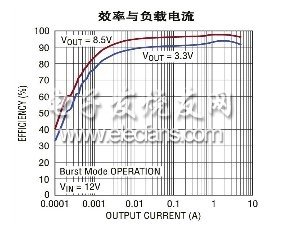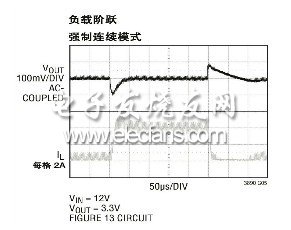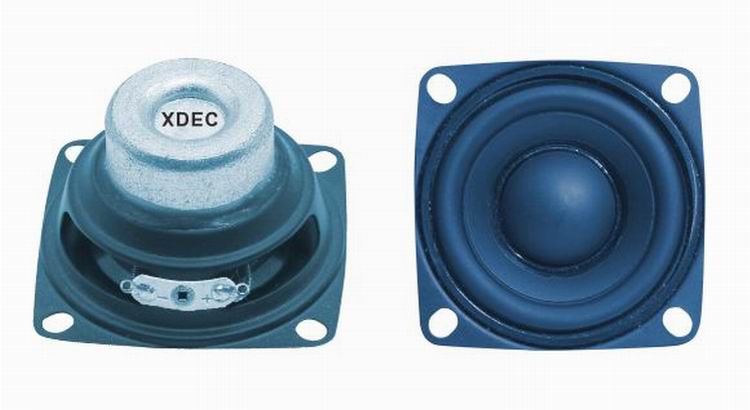The automotive and heavy equipment environment is very harsh for any type of electronics. The wide operating voltage requirements combined with large voltage transients and wide temperature variations combine to make the electronic system in a very tough working environment. To complicate considerations, the number of voltage rails in electronic systems is also increasing. For example, a typical navigation system might have six or more different power supplies, including 8.5V, 5V, 3.3V, 2.5V, 1.8V, and 1.5V. At the same time, as the number of components increases, the available space is shrinking. Therefore, due to space constraints and high temperature conditions, high efficiency conversions are becoming more important to minimize power consumption.
This article refers to the address: http://
As a result, a good switching regulator for cars and trucks needs to operate over a wide input voltage range of 4V to 60V. The 60V rating provides a good margin for a 12V system that is typically clamped in the 36V to 40V range. In addition, in dual-battery applications that can be seen in trucks and heavy equipment, even higher operating voltages are required due to their 24V nominal battery voltage. Most of these applications are clamped to a maximum operating voltage of 58V, so a 60V rating is usually sufficient. Overvoltage clamps are required on cars and trucks to limit the maximum transient voltage caused by the inductive retrace voltage of the engine starter.
There are many car and truck systems that require continuous power supply even when the vehicle engine is not running, such as a remote door opening system and an alarm system. For such "always on" systems, it is important to have a DC/DC converter with low quiescent current because it maximizes battery run time while in sleep mode. In this type of environment, the regulator operates in the usual continuous switching mode until the output current drops below a preset threshold of 30mA to 50mA. Below this value, the switching regulator must go into Burst Mode? operation to reduce the quiescent current to within tens of uA, thereby reducing the power drawn from the battery to extend battery run time.
Due to insufficient supply of 60V input DC/DC converters, some designers turned to transformer-based topologies or external high-side drivers to operate at voltages up to 60V. Other designers use intermediate bus converters that require additional power stages. Both types of alternative solutions increase design complexity and, in most cases, reduce overall efficiency. However, Linear Technology offers the LTC3890. This is the latest addition to a growing family of 60V input step-down switching regulator controllers that address many of the key issues encountered in automotive and truck applications mentioned above. Figure 1 shows the operation of the LTC3890 in converting 9V to 60V inputs to 3.5V/5A and 8.5V/3A output applications.

Figure 1: The LTC3890 converts 9V to 60V inputs to 8.5V/3A and 3.3V/5A outputs
introduction
The LTC3890/-1 is a high voltage, dual output synchronous step-down DC/DC controller that consumes only 50uA during one output operation and 60uA when both outputs are enabled. When both outputs are turned off, the LTC3890/-1 consumes only 14uA. Its 4V to 60V input supply range protects the device from high voltage transients and operates continuously in automotive, heavy equipment and truck cold start and covers a wide range of input power and battery chemistries. With output currents up to 20A, each output can be set from 0.8V to 24V with an efficiency of up to 98%, making the device ideal for 12V or 24V automotive, truck, heavy equipment and industrial control applications.
The LTC3890/-1 operates from an optional fixed frequency range of 50kHz to 900kHz and can be synchronized to an external clock from 75kHz to 850kHz with its phase-locked loop (PLL). At light loads, the user can select continuous operation, pulse skipping, and low ripple burst mode operation. The two-phase operation of the LTC3890 reduces input filtering and capacitance requirements. Its current mode architecture provides convenient loop compensation, fast transient response and excellent voltage regulation. Output current sensing is accomplished by measuring the voltage drop across the output inductor (DCR) for maximum efficiency, or optional sense resistors can be used for output current sensing. Current foldback limits the amount of heat generated by the MOSFET during an overload condition. These features combined with a minimum turn-on time of only 95ns make the controller ideal for high step-down ratio applications.
The device is available in two versions: The LTC3890 is a full-featured device that includes clock output, clock phase modulation, two separate power good outputs, and adjustable current limit. The LTC3890-1 does not have these additional features and is available in a 28-pin SSOP package. The LTC3890 is available in a 32-lead 5mm x 5mm QFN package.
Burst mode operation, pulse skipping or forced continuous mode
The LTC3890/-1 can be programmed to enter high efficiency burst mode operation, constant frequency pulse skipping or forced continuous conduction mode at low load currents. When configured to operate in burst mode and at light loads, the converter will generate several bursts to keep the charging voltage on the output capacitor constant. The device then shuts down the converter and enters sleep mode where most of the internal circuitry is off. The output capacitor provides the load current, and when the voltage across the output capacitor drops to a set value, the converter begins to support providing more current to supplement the charging voltage. Turning off most of the internal circuitry greatly reduces the quiescent current.
In addition, the inductor current is not allowed to reverse when the controller is started to enter burst mode operation. Just before the inductor current reaches zero, the reverse current comparator IR turns off the bottom external MOSFET to prevent it from becoming negative. Therefore, when configured in burst mode, the controller also operates in discontinuous mode.
In addition, the inductor current is allowed to reverse under light load or large transient conditions when forced continuous operation or when a clock signal is provided by an external clock source. Continuous operation has the advantage of lower output voltage ripple, but produces higher quiescent current.
Overcurrent protection
Fast and accurate current limiting protection is important in high voltage power supplies. Because the voltage across the inductor is high when the output is shorted, the inductor can quickly saturate, causing excessive current to flow. The LTC3890/-1 offers the option of detecting the output current with a sense resistor in series with the output or by detecting the output voltage across the output inductor. Either way, the output current is continuously monitored and provides the highest level of protection. Some alternative designs may use the RDS(ON) of the top or bottom MOSFET to detect the output current. However, this causes a period of time during which the controller "invisible" the output current during the switching cycle and may cause converter failure. Powerful gate driver
Switching losses are proportional to the square of the input voltage, and these losses are most likely to be high in high input voltage applications where gate drivers are not good enough. The LTC3890/-1 has a powerful 1.1Ω internal N-channel MOSFET gate driver that minimizes conversion time and switching losses to maximize efficiency. In addition, it can drive multiple parallel MOSFETs for higher current applications.
effectiveness
The LTC3890 efficiency curve shown in Figure 2 is an example of the schematic of Figure 1 with a 12V input voltage. As shown, the 8.5V output can produce very high efficiencies as high as 98%. The efficiency is also over 90% at 3.3V. In addition, this design still exceeds 75% efficiency at each output with a 1mA load, which is due to burst mode operation.

Figure 2: LTC3890's 12V input to 8.5V and 3.3V output efficiency curves
Efficiency vs Load Current: Efficiency vs. Load Current
Fast transient response
The LTC3890 implements voltage feedback with an amplifier that operates at a fast 25MHz bandwidth. High bandwidth amplifiers combine high switching frequency and low value inductors, allowing very high gain crossover frequencies. This allows the compensation network to be optimized for very fast load transient response. Figure 3 illustrates the transient response of a 4A step load on a 3.3V output, with a deviation of less than 100mV from the nominal value.

Figure 3: Transient response curve of the LTC3890 at 4A load step
Load Step: Load step
Forced Continuous Mode: Forced Continuous Mode
2A/DIV: 2A per division
in conclusion
The LTC3890 provides features that make it ideal for high input voltage supplies. It provides a higher level of performance in terms of the need to work safely and efficiently in harsh high-voltage transient environments. A variety of features, including 60V input capability, make it ideal for automotive dual battery, truck and heavy equipment applications. Its low quiescent current saves battery energy in sleep mode, allowing for longer battery run times, which is a very useful feature in the "always on" bus system.
In addition, the LTC3890 has an output voltage of up to 24V and is very easy to generate multiple output voltages. Alternatively, its small minimum on-time allows the LTC3890 to be used in high step-down ratio applications. Reducing the input voltage directly from 60V without the need for bulky transformers or external protection makes it possible to create an economical and compact solution.
Speakers with working frequency response range from 150~15000Hz are called full range speakers.


FAQ
Q1. What is the MOQ?
XDEC: 2000pcs for one model.
Q2. What is the delivery lead time?
XDEC: 15 days for normal orders, 10 days for urgent orders.
Q3. What are the payment methods?
XDEC: T/T, PayPal, Western Union, Money Gram.
Q4. Can you offer samples for testing?
XDEC: Yes, we offer free samples.
Q5. How soon can you send samples?
XDEC: We can send samples in 3-5 days.
Full Range Speaker
Full Range Speaker,Full Range Loudspeakers,Range Speaker,Small Full Range Speakers
Shenzhen Xuanda Electronics Co., Ltd. , https://www.xdecspeaker.com